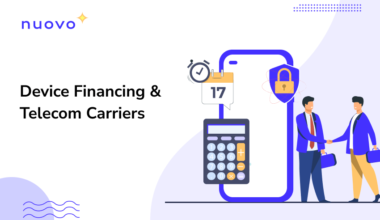Mobile devices were introduced to the consumer world in the 1980s and since then there has been no looking back. Smartphones, tablets and laptops are the most used digital devices today. From mobile commerce to online education, people rely on these commercial and handy devices. The pandemic-driven remote working has further accelerated the adoption of mobile devices for instant connectivity.

It is safe to say that mobile devices that were once a privilege, are now a necessity. However, a necessity as costly as this can present a challenge to several people in the world. The prices of mobile devices, although lower than what they were when they entered the market, are still unaffordable for many.
Financing companies are extending device financing plans to make smartphones and other digital devices affordable. However, there still remains skepticism toward the concept of device financing. Consumers are confused between buying or financing their devices. Financers are challenged with several critical pain points.
This leaves the “device buying vs. financing” debate unresolved.
What is Device Financing?
Device financing is a payment model that helps customers to buy the devices of their choice and pay installments over time. Instead of making a one-time hefty down payment, users can apply for device financing and pay off the amount in monthly installments. The financing terms and conditions vary depending on which financing institution you are applying to. Some may extend a 24 to 48 months payment tenure, others may offer you 0% interest on full payment.
The primary goal is to make the latest devices accessible to people who cannot afford to purchase these costly devices. With this, people from economically weak regions of the world can also afford a smartphone, students can afford a laptop or tablet for their higher education or distance learning.
The Difference Between Device Leasing & Device Financing
Device leasing and device financing are both ways to obtain devices but with a difference in ownership. Both methods allow users to gain instant access to expensive devices, without paying the entire amount at once.
Device leasing is where you rent the device from the leaser. In this case, the user never fully owns the device. He simply pays monthly rent for the device and can return the device back to the leasing company once his needs are met. However, some leading companies offer the user to buy out the device at the end of the leasing term by paying the difference. But not all leasing firms will offer this option.
Device financing, on the other hand, is an economic way to finance your device. Consider it as a device loan. Your device lender will let you fan out the payment over a fixed period. Users can make small monthly payments. Once the cost of the device and the interest amount, if any have been repaid, the user gets full ownership of the device.
Types of Device Financing
Device financing has different forms depending on the terms placed by the financial institutions. Here’s an overview of the different types of financed devices to make an informed choice.
1. Retail Device Financing
Users can opt for a financed device through a retail store. To leverage this sort of device financing users may have to undergo a hard credit inquiry to assess their ability to repay the loan.
2. Financing Through Device Provider
Device providers such as cellphone companies also extend device financing options for users. This involves a contract that is signed by the user with the device providers for a fixed tenure.
3. Device Manufacturer Financing
Another method to obtain financed devices is to approach the device manufacturers. Several device manufacturers such as Samsung and Apple offer promotional device financing for their newly launched products.
4. BNPL
Buy Now Pay Later (BNPL) is a short-term financing scheme. It is also known as the point-of-sale installment loan. This financing plan lets the users buy the device with a small down payment and then fan out the rest of the amount in a fixed number of installments.
Device Financing vs. Buying: Choose What’s Best for You

Whether a user wants to opt for device buying or financing depends solely on their use case. A majority of the world still believes in purchasing devices at full price. There are definitely certain perks of buying devices, as compared to leasing or financing them. Buying a device means that the user fully owns the device. Users have complete ownership of the device and are free to use it or customize it as per their liking. This, however, is not the case in device financing. Until the users fulfill the entire buying price of the device, they are not the sole owners of the device. Users have to constantly ensure safe and proper usage of the devices and cannot experiment much with device customizations.
When leasing or financing a device, users have to present a set of documents, undergo financial background checks and lengthy procedures that financial institutions execute to ensure the ability of the user to pay his dues. This is not the case with device buying. Purchasing a device is simple, fast and a one-time process.
There is no definitive solution to selecting the right option between buying or financing. However, it does take away the biggest hurdle of high device costs. Users can fan out their payments in small periodic installments instead of paying huge upfront costs.

Advantages of Financing Devices
Although purchasing devices by paying the entire cost upfront is how a majority of the world buys digital devices, device financing is slowly but constantly gaining popularity due to its powerful benefits.
Let’s understand why device financing is favored over traditional buying by several people in the world.
1. Cost-Effectiveness
Device financing is a concept that has not been accepted fully by the people. Not everyone has understood the concept of financing a device. Some believe that device financing is the same as device leasing. They shun the idea thinking, that they would eventually end up paying much more than the price they would pay for purchasing the device. However, financed devices do not require the user to pay over the buying price. Once the user pays off the cost of the device, he has the option to keep the device as his own. Device financing simply fans out the payment in smaller bits helping the users to manage their finances better.
2. No Maintenance
Speaking of costs, when a user opts for a financed device, he is not the complete owner of the device until he pays the entire buying price. This means that the user is not responsible for any repair, maintenance or routine upgrade costs involved. The financing companies generally take care of any fixtures or upgrades that their devices require.
3. Greater Flexibility
Buying a device is a long-term commitment. Once a user has paid hefty amounts of money to purchase a device, he is obligated to use it for as long as he can. With device financing, users can switch or upgrade their devices to the latest versions whenever they feel like it.
4. Improved Credit Score
Financing a device and paying the EMI installments on time can help users improve their credit scores. A good credit score helps users apply for other types of credits and gain better interest rates.
Device Financing Pain Points
Device financing has great benefits for the users. However, financing companies hesitate to extend such device financing plans due to some very critical challenges that they face. The credit score system helps financial institutions to assess a user’s ability to pay the EMIs. However, there are several regions of the world that do not have a credit score system in place.
Following are some of the major concerns that device financers have:
1. Tracking a Large Number of Financed Devices
When creating a device financing plan, companies have to keep in mind the excessive management and tracking that would be involved in gaining constant visibility of their devices. Simply providing devices to users is not enough. Financing companies are challenged with maintaining a record of their numerous devices.
2. Risk of Device Theft or Loss
One of the biggest security concerns faced by financing companies is device loss or theft. In regions that lack a credit score system, if a user happens to steal the financed device, there is no sure shot method for device recovery. Financing companies are challenged with building a strong mitigation strategy, should they encounter such a fraudulent situation.
3. Delayed Payments and EMI Fraud
Users not paying their EMIs on time is easily one of the most common drawbacks of device financing or leasing. Keeping a track of the payment calendar of thousands of devices, ensuring timely payments and tracking down the defaulters is a tedious and concerning task for the financing companies.
4. Customers Swapping Pre-bundled SIM Services
Several device financing plans involve a hardware solution that is pre-bundled with SIM services. The SIM services are inclusive of the payment scheme. However, once the lock-in period is over, users may remove the pre-installed SIM card and switch it for cheaper alternatives. This presents great losses for any telecom carriers that the financing companies may partner with.
Risk-Free Device Financing With Nuovopay
Financing companies have the power to bridge the gap between the digitally divided worlds. However, the security risks involved in device financing hold them back from organizing financing plans. The only way to truly overcome the digital divide is to reinforce the security concerns that financing companies face. NuovoPay is a robust solution that helps financing companies to mitigate their challenges with its powerful feature set.
1. Automate EMI Payment Alerts
NuovoPay allows financing companies to schedule automated payment reminders to notify the users of their upcoming payments. You can create and schedule payment reminders in just a few clicks. The NuovoPay dashboard also offers a set of pre-written reminder templates for you to choose from. The payment reminder statuses can also be tracked from the dashboard itself. This ensures that the users are aware of their payment schedules in advance and process payments without delays.
2. Integrate Billing System Providers
NuovoPay enables device financing companies to integrate leading billing system software with its dashboard. This helps the financing companies to declutter their payment records. External billing software solutions help financing companies in simplifying complex tasks such as maintaining payment statuses, tracking receipts and inventory details.
3. Remote Device Locking
The biggest concern of users not paying their EMI on time can be mitigated with NuovoPay’s remote locking technology. Financing companies can leverage the NuovoPay dashboard to remotely lock their defaulters’ devices. The first lock date and next lock date can be configured before automating the payment reminders.
If users fail to pay their EMI on time, their devices can be remotely locked and rendered unfit for use. Once the installment has been paid, the user’s device can be unlocked from the dashboard. Locking the user’s device has no effect on the user’s private data stored on it. All the data can be retrieved as it is once the device is unlocked. NuovoPay’s Remote device locking capabilities can be deployed even if the device is offline. It prevents users from stealing or selling their financed devices.
4. SIM-Based Locking
Financing companies often partner with telecom carriers to extend device financing plans that involve pre-bundled SIM services for the users. The monthly installment and payment scheme are inclusive of the telecom services. But users can easily misuse this scenario to swap the pre-installed SIM card with a cheaper alternative.
NuovoPay helps financing companies to secure their pre-installed SIM card and maintain partner loyalty and trust. NuovoPay’s SIM-based Locking feature remotely blocks access to the device if the user attempts to remove the pre-installed SIM card.
Why Is Nuovopay the Best Security Solution for Financing Companies?
NuovoPay extends a device locking technology to help financing companies enter the device financing market with confidence. Financers need not worry about security aspects such as device fraud or payment delays even in regions that do not have a credit score system.
Financing companies can explore uncharted markets and tap into new revenue streams. NuovoPay helps financers with a robust security solution that enables them to manage the critical pain points of device financing. Nuovopay helps you to bridge the gap between the digitally divided world and offers an assured payment requisition.
Closing Lines
There’s no right or wrong when it comes to the choice between device buying and financing. However, with device financing, smartphones, laptops and other commercial devices can be made much more accessible to the world. Financing companies can make the most of their device financing scheme by securing them with a robust solution. NuovoPay is a powerful solution built to simplify and secure device financing.






